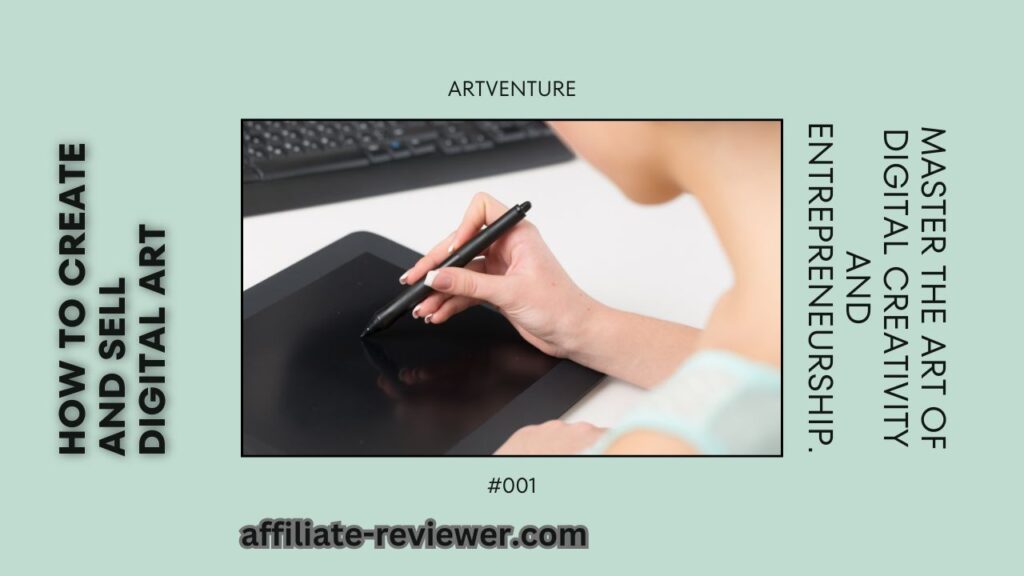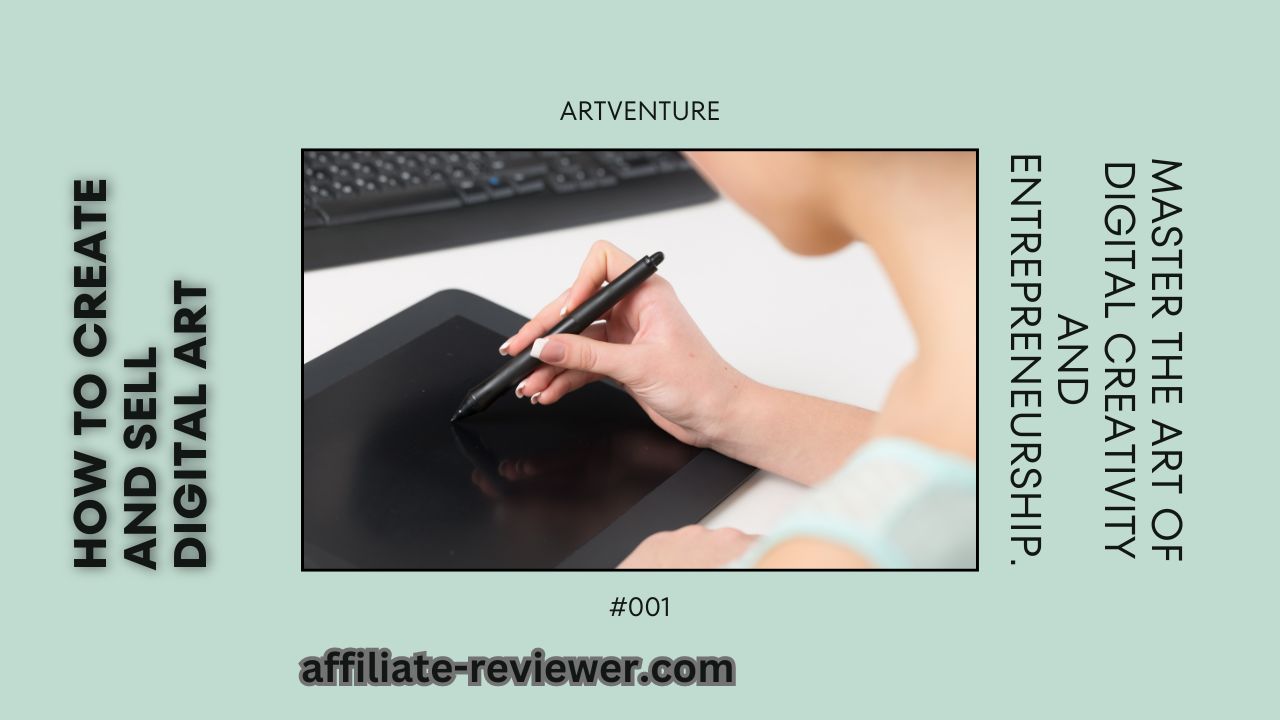Hey I’m Noyon, Welcome to my article How to Create and Sell Digital Art
In the vibrant world of creativity, digital art has carved out a significant niche. But what exactly is digital art? At its core, digital art refers to artistic works created using digital technology. From stunning illustrations to intricate animations, digital art spans various forms and styles, reflecting the endless possibilities of the digital realm. In today’s technology-driven world, the importance of digital art cannot be overstated. It’s not just a hobby; it’s a booming industry with artists around the globe making a living through their digital creations. Join our workshop to learn how to create and sell digital art like a pro.
Frustrated? Forget your Boring 9 – 5 Job and JOIN HERE! Unlock Your Online Success!

Getting Started with Digital Art
Choosing the Right Tools and Software
The first step in your digital art journey is selecting the right tools. Popular software options include Adobe Photoshop, Illustrator, Corel Painter, and Procreate. Each of these has its strengths, so try out a few to see which aligns best with your style. You can easily create and sell digital art by following these simple steps.
Essential Hardware Requirements
Having the right hardware is equally important. A powerful computer with a good graphics card, a high-resolution monitor, and a reliable digital drawing tablet are essential. Tablets like Wacom or iPad Pro with an Apple Pencil are favorites among digital artists for their precision and ease of use. Our course teaches you how to create and sell digital art from scratch.
Basic Skills to Master
Before diving in, familiarize yourself with basic digital art skills. These include understanding how to use layers, selecting and using different brushes, and navigating your chosen software’s interface. These foundational skills will set you up for more advanced techniques down the line.
Frustrated? Forget your Boring 9 – 5 Job and JOIN HERE! Unlock Your Online Success!
Selecting Your Digital Art Style
Exploring Different Styles of Digital Art
Digital art is incredibly versatile. You might be drawn to realistic portraits, abstract designs, pixel art, or even 3D modeling. Explore various styles to see what resonates with you.
Finding Your Unique Artistic Voice
Finding your unique voice is crucial. Experiment with different techniques and styles until you find one that feels authentically you. Your unique style will help you stand out in a crowded market.
Understanding Current Trends
Stay updated with current trends in the digital art world. Whether it’s a new style gaining popularity or emerging tools and techniques, being in the know can help you stay relevant and inspired.
Learning the Basics
Mastering Fundamental Techniques
Start with the basics—shading, blending, and sketching. These techniques form the backbone of your artwork. Practice regularly to build confidence and skill.
Importance of Color Theory
Understanding color theory is essential. Learn about color relationships, how to create harmony in your artwork, and how different colors can evoke various emotions.
Understanding Composition and Perspective
Composition and perspective are key to creating visually appealing art. Study the rule of thirds, leading lines, and how to create depth in your artwork through proper perspective techniques.
Advanced Techniques in Digital Art
Using Layers Effectively
Layers are a digital artist’s best friend. They allow you to separate different elements of your artwork, making editing and adjustments easier.
Incorporating Textures and Effects
Textures and effects can add depth and realism to your art. Experiment with different brushes and effects to find what works best for your style.
Advanced Brush Settings and Customization
Customize your brushes to suit your needs. Many digital art programs allow for extensive brush customization, letting you create brushes that mimic traditional media or achieve specific effects.
Frustrated? Forget your Boring 9 – 5 Job and JOIN HERE! Unlock Your Online Success!
Creating Your First Digital Artwork
Step-by-Step Process from Concept to Completion
Creating your first piece can be daunting. Start with a concept or rough sketch, then gradually refine it. Use layers to add details, and don’t be afraid to make mistakes—they’re part of the learning process.
Common Challenges and How to Overcome Them
You might face challenges like artist’s block or frustration with your tools. Take breaks, seek inspiration from other artists, and remember that perseverance is key.
Tips for Refining and Finalizing Your Piece
Once your artwork is nearly complete, take the time to refine it. Zoom in to add details, adjust colors and contrast, and make sure everything is cohesive.
Building a Digital Art Portfolio
Importance of a Strong Portfolio
A strong portfolio showcases your best work and is crucial for attracting clients or customers. It reflects your skills, style, and versatility.
What to Include in Your Portfolio
Include a variety of pieces that demonstrate your range. Show both finished works and sketches or process shots to give insight into your creative process.
How to Present Your Work Professionally
Present your work in a clean, organized manner. Use high-quality images, provide descriptions, and arrange your portfolio to highlight your strengths.
Establishing an Online Presence
Creating a Website or Blog
A professional website or blog serves as your online gallery. Use it to showcase your portfolio, share your process, and connect with potential clients.
Utilizing Social Media Platforms
Social media is a powerful tool for digital artists. Platforms like Instagram, Twitter, and Pinterest can help you reach a wider audience and engage with the art community.
Engaging with the Digital Art Community
Join online forums, participate in challenges, and collaborate with other artists. Engaging with the community can provide support, inspiration, and networking opportunities.
Frustrated? Forget your Boring 9 – 5 Job and JOIN HERE! Unlock Your Online Success!
Marketing Your Digital Art
Effective Marketing Strategies
Use a mix of marketing strategies, including social media, email newsletters, and online ads. Consistency and authenticity are key to building a loyal following.
Understanding Your Target Audience
Identify who your target audience is—whether it’s fellow artists, potential clients, or art enthusiasts. Tailor your content and marketing efforts to appeal to them.
Networking and Collaboration Opportunities
Networking can open doors to new opportunities. Attend online art events, join artist groups, and don’t hesitate to reach out to other artists for collaborations.
Selling Your Digital Art
Different Platforms to Sell Your Art
There are various platforms to sell your art, including Etsy, Redbubble, and Society6. Each platform has its pros and cons, so choose the one that best fits your needs.
Pricing Strategies
Pricing your art can be tricky. Consider factors like your experience, the complexity of the piece, and market trends. Don’t undervalue your work, but also stay competitive.
Licensing and Legal Considerations
Understand the basics of licensing your art. Whether it’s for commercial use or personal projects, make sure you’re aware of your rights and how to protect your work.
Using Online Marketplaces
Overview of Popular Marketplaces
Popular marketplaces like Etsy, ArtStation, and DeviantArt offer different features and audiences. Research each to find the best fit for your art.
Pros and Cons of Each Platform
Each platform has its strengths and weaknesses. Etsy is great for handmade items, while ArtStation is geared towards professional artists. Choose based on your goals and audience.
Tips for Standing Out
To stand out, focus on high-quality images, clear descriptions, and consistent branding. Engage with your customers and seek feedback to continually improve.
Frustrated? Forget your Boring 9 – 5 Job and JOIN HERE! Unlock Your Online Success!
Setting Up an Online Store
Choosing the Right E-Commerce Platform
Platforms like Shopify, Big Cartel, and Squarespace offer robust solutions for setting up an online store. Consider ease of use, customization options, and cost.
Setting Up Your Store Step-by-Step
From choosing a domain name to designing your store layout, follow a step-by-step approach. Ensure your store is user-friendly and visually appealing.
Optimizing Your Store for SEO
SEO is crucial for attracting traffic. Use relevant keywords, optimize product descriptions, and ensure your website loads quickly and is mobile-friendly.
Promoting Your Digital Art
Utilizing Email Marketing
Build an email list and send regular newsletters with updates, new releases, and special offers. Email marketing can be a powerful tool for driving sales.
Running Online Ads
Invest in online advertising through platforms like Google Ads and Facebook Ads. Target your ads to reach your ideal audience and track performance to optimize results.
Leveraging Influencers and Partnerships
Collaborate with influencers or partner with other artists and brands. These partnerships can help you reach a broader audience and boost your credibility.
Maintaining Your Digital Art Business
Managing Finances and Taxes
Keep track of your income and expenses, and understand your tax obligations. Consider using accounting software or hiring a professional to manage your finances.
Customer Service Best Practices
Provide excellent customer service by responding promptly to inquiries, handling issues professionally, and building positive relationships with your customers.
Continuously Improving Your Skills
Frustrated? Forget your Boring 9 – 5 Job and JOIN HERE! Unlock Your Online Success!
Stay ahead by continually improving your skills. Take online courses, attend workshops, and keep experimenting with new techniques and styles.
Creating and selling digital art is a rewarding journey that blends creativity with entrepreneurship. By mastering the basics, finding your unique style, and effectively marketing your work, you can turn your passion into a thriving business. Remember, success in the digital art world requires dedication, continuous learning, and a willingness to adapt to changing trends.


I find it incomprehensible that you are not more popular than you already are, given your intelligence. I was able to look at this topic from a number of angles because of your depth of knowledge. It appears that until a conversation turns to Woman gaga, neither men nor women seem to be really interested in things related to women. Continue your fantastic work.
Thank you so much for your kind words and encouragement! It means a lot to me. I’m glad to hear that my insights and knowledge have provided you with different perspectives on the topic. While topics like Lady Gaga may garner more attention, I believe there’s value in discussing a wide range of subjects related to women and beyond. I appreciate your support, and I’ll continue to do my best in providing valuable content.